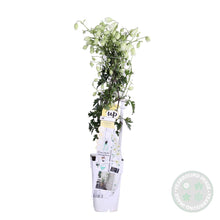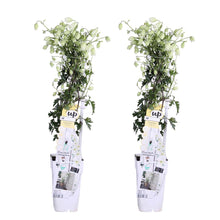Clematis 'Avalanche' is a stunning and widely admired Clematis cultivar, celebrated for its abundant display of large, pure white flowers. This deciduous climber graces gardens with a breathtaking cascade of blooms in late spring and early summer. Each flower boasts six to eight overlapping petals, creating a simple yet elegant effect, and emits a delicate, sweet fragrance. Its vigorous growth habit and beautiful flowers make it an excellent choice for adorning trellises, arbors, fences, and walls, adding a touch of classic beauty and sophistication to any landscape. It is classified as a member of the Ranunculaceae family.
Origin: Clematis 'Avalanche' was bred in the Netherlands.
Light: Clematis 'Avalanche' thrives in a position with full sun to partial shade. Ideally, it prefers at least 6 hours of sunlight per day to encourage optimal growth and flowering, but it can tolerate some shade, especially in hotter climates.
Water: Consistent watering is important, especially during dry periods and in the first year after planting. This Clematis prefers consistently moist soil that is also well-drained. Avoid overwatering, which can lead to root rot.
Soil: Clematis 'Avalanche' prefers fertile, well-drained soil. It thrives in loamy soil with a slightly alkaline to neutral pH.
Support: As a climbing vine, Clematis 'Avalanche' needs support to grow. Provide a trellis, fence, or other structure for it to climb on.
Pruning: This Clematis falls into pruning group 2, meaning it flowers on both old and new wood. A light pruning in late winter or early spring is recommended, removing any dead or weak stems. After the first flush of blooms in early summer, you can prune back some of the flowered stems to encourage further flowering later in the season.
Pests and Diseases: Be vigilant for common Clematis pests and diseases, such as slugs, snails, aphids, and Clematis wilt.
Uses: Clematis 'Avalanche' is primarily grown as an ornamental vine for its beautiful and elegant flowers. It's a popular choice for trellises, arbors, fences, and walls, adding a touch of timeless beauty to gardens and landscapes.
Toxicity: Clematis can be mildly toxic to humans and pets if ingested, causing mouth irritation and stomach upset.



